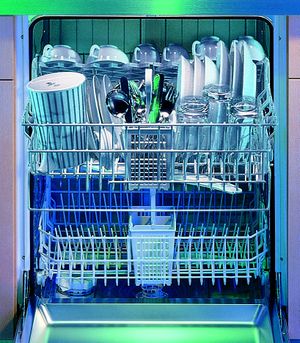AquaSensor
It goes without saying when washing by hand: The water is only changed once it gets too dirty. BSH[1] launched a dishwasher on the market in 1996 whose electronics thought along these lines. The appearance of the new GV630 range of dishwashers attracted lots of attention among competitors and testing institutes.Referenzfehler: Für ein <ref>-Tag fehlt ein schließendes </ref>-Tag.
This posed a tantalizing challenge for the present day head of the Dishwasher Care production division Michael Rosenbauer, who was an engineer at the time in Dillingen. He recognized the potential that lay in developing these sensors. His efforts resulted in the development of a turbidity sensor that detected the degree of dirt of the water. The development was called AquaSensor – based on the successful water damage protection solution AquaStop.[2]
The AquaSensor was integrated in the new GV630 dishwasher series and controlled the reusage or draining of the pre-rinse water by checking the cloudiness of the water. The AquaSensor thus helped save around 20 percent of the washing water.[3]
Operation of the AquaSensor
An infrared LED and phototransistor were arranged opposite each other on a U-shaped board and protected by housing made from translucent plastic. This sensor was integrated in the instantaneous water heater. The infrared diode then sent its light through the flowing water to the light-sensitive base of the phototransistor, which became conductive when irradiated by light. When the water became cloudy, the light could no longer reach the diode to activate the phototransistor. The absent voltage signal was detected by the microcomputer on the electronic circuit board and this then initiated the required replacement of the water.[4]
A preset time and regeneration electronics were also integrated in the controller. The latter only initiated regeneration of the water softening unit with salt when this was deemed necessary based on the set water hardness level and the dishwasher programs used. This avoided unnecessary consumption of salt and regeneration water.[5]
Bavarian Innovation Prize 2000
Ende Juni 2000 erhält das Entwicklerteam Geschirrspüler aus Dillingen von Ministerpräsident Dr. Edmund Stoiber für den neuen vollautomatischen Geschirrspüler den Bayerischen Innovationspreis überreicht. Die Laudatio hält der Physiker und ehemalige Astronaut Dr. Ulf Merbold und lobt das Gerät, in dem der AquaSensor eine zentrale Rolle spielt, mit folgenden Worten: „Der hier auszuzeichnende Geschirrspüler wählt als einziger weltweit das jeweils optimale Spülprogramm, ohne dass der Benutzer eingreifen muss. An der Verschmutzung des Wassers wird erkannt, welches Spülprogramm zugleich effektiv das Geschirr reinigt und die sparsamsten Wasser- und Energiewerte hat. Damit schont er nicht nur den Geldbeutel des Anwenders, sondern auch die Umwelt."[6]
Einzelnachweise
- ↑ BSH was founded in 1967 as Bosch-Siemens Hausgeräte GmbH - BSHG for short. In 1998, the name was changed to BSH Bosch und Siemens Hausgeräte GmbH, with the short form BSH. Since the sale of the Siemens shares in BSH to Robert Bosch GmbH the company’s name is now BSH Hausgeräte GmbH, but still BSH for short.
- ↑ BSH Corporate Archives, F-BSH-004, Stickel: Spülchronik, page 164.
- ↑ BSH Corporate Archives, F-BSH-004, Stickel: Spülchronik, page 164.
- ↑ BSH Corporate Archives, Edition Ernst Stickel (uncatalogued), drawing of the sump assembly in the GV630.
- ↑ BSH Corporate Archives, F-BSH-004, Stickel: Spülchronik, page 164.
- ↑ BSH-Konzernarchiv, A05-0023, inform 2000/August S. 13.
